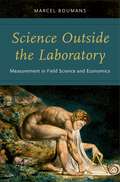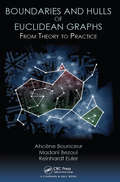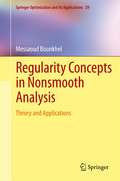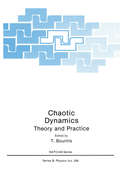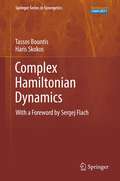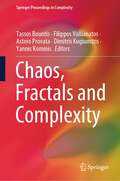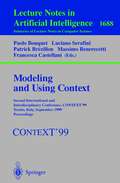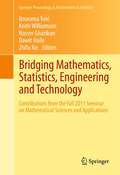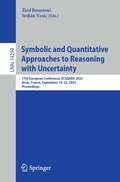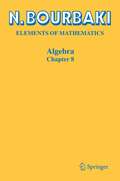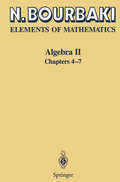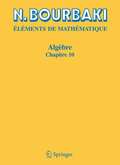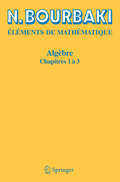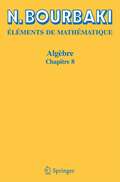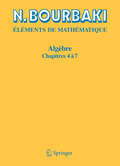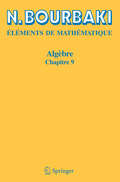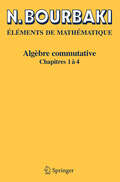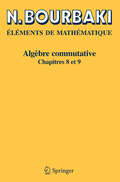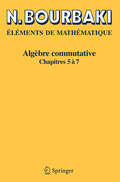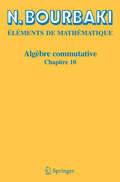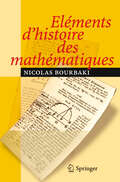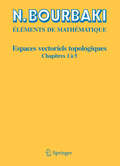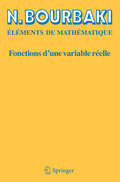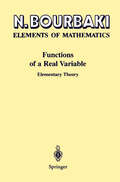- Table View
- List View
Science Outside the Laboratory: Measurement in Field Science and Economics
by Marcel BoumansThe conduct of most of social science occurs outside the laboratory. Such studies in field science explore phenomena that cannot for practical, technical, or ethical reasons be explored under controlled conditions. These phenomena cannot be fully isolated from their environment or investigated by manipulation or intervention. Yet measurement, including rigorous or clinical measurement, does provide analysts with a sound basis for discerning what occurs under field conditions, and why. In Science Outside the Laboratory, Marcel Boumans explores the state of measurement theory, its reliability, and the role expert judgment plays in field investigations from the perspective of the philosophy of science. Its discussion of the problems of passive observation, the calculus of observation, the two-model problem, and model-based consensus uses illustrations drawn primarily from economics. Rich in research and discussion, the volume clarifies the extent to which measurement provides valid information about objects and events in field sciences, but also has implications for measurement in the laboratory. Scholars in the fields of philosophy of science, social science, and economics will find Science Outside the Laboratory a compelling and informative read.
Boundaries and Hulls of Euclidean Graphs: From Theory to Practice
by Ahcene Bounceur Madani Bezoui Reinhardt EulerBoundaries and Hulls of Euclidean Graphs: From Theory to Practice presents concepts and algorithms for finding convex, concave and polygon hulls of Euclidean graphs. It also includes some implementations, determining and comparing their complexities. Since the implementation is application-dependent, either centralized or distributed, some basic concepts of the centralized and distributed versions are reviewed. Theoreticians will find a presentation of different algorithms together with an evaluation of their complexity and their utilities, as well as their field of application. Practitioners will find some practical and real-world situations in which the presented algorithms can be used.
Boundaries and Hulls of Euclidean Graphs: From Theory to Practice
by Ahcene Bounceur Madani Bezoui Reinhardt EulerBoundaries and Hulls of Euclidean Graphs: From Theory to Practice presents concepts and algorithms for finding convex, concave and polygon hulls of Euclidean graphs. It also includes some implementations, determining and comparing their complexities. Since the implementation is application-dependent, either centralized or distributed, some basic concepts of the centralized and distributed versions are reviewed. Theoreticians will find a presentation of different algorithms together with an evaluation of their complexity and their utilities, as well as their field of application. Practitioners will find some practical and real-world situations in which the presented algorithms can be used.
Regularity Concepts in Nonsmooth Analysis: Theory and Applications (Springer Optimization and Its Applications #59)
by Messaoud BounkhelThe results presented in this book are a product of research conducted by the author independently and in collaboration with other researchers in the field. In this light, this work encompasses the most recent collection of various concepts of regularity and nonsmooth analysis into one monograph. The first part of the book attempts to present an accessible and thorough introduction to nonsmooth analysis theory. Main concepts and some useful results are stated and illustrated through examples and exercises. The second part gathers the most prominent and recent results of various regularity concepts of sets, functions, and set-valued mappings in nonsmooth analysis. The third and final section contains six different application, with comments in relation to the existing literature.
Chaotic Dynamics: Theory and Practice (Nato Science Series B: #298)
by T. BountisMany conferences, meetings, workshops, summer schools and symposia on nonlinear dynamical systems are being organized these days, dealing with a great variety of topics and themes -classical and quantum, theoretical and experimental. Some focus on integrability, or discuss the mathematical foundations of chaos. Others explore the beauty of fractals, or examine endless possibilities of applications to problems of physics, chemistry, biology and other sciences. A new scientific discipline has thus emerged, with its own distinct philosophical viewpoint and an impressive arsenal of new methods and techniques, which may be called Chaotic Dynamics. Perhaps its most outstanding achievement so far has been to shed new light on many long standing issues involving complicated, irregular or "chaotic" nonlinear phenomena. The concepts of randomness, complexity and unpredictability have been critically re-examined and the fundamental importance of scaling, self-similarity and sensitive dependence on parameters and initial conditions has been firmly established. In this NATO ASI, held at the seaside Greek city of Patras, between July 11- 20, 1991, a serious effort was made to bring together scientists representing many of the different aspects of Chaotic Dynamics. Our main aim was to review recent advances, evaluate the current state of the art and identify some of the more promising directions for research in Chaotic Dynamics.
Complex Hamiltonian Dynamics (Springer Series in Synergetics #10)
by Tassos Bountis Haris SkokosThis book introduces and explores modern developments in the well established field of Hamiltonian dynamical systems. It focuses on high degree-of-freedom systems and the transitional regimes between regular and chaotic motion. The role of nonlinear normal modes is highlighted and the importance of low-dimensional tori in the resolution of the famous FPU paradox is emphasized. Novel powerful numerical methods are used to study localization phenomena and distinguish order from strongly and weakly chaotic regimes. The emerging hierarchy of complex structures in such regimes gives rise to particularly long-lived patterns and phenomena called quasi-stationary states, which are explored in particular in the concrete setting of one-dimensional Hamiltonian lattices and physical applications in condensed matter systems. The self-contained and pedagogical approach is blended with a unique balance between mathematical rigor, physics insights and concrete applications. End of chapter exercises and (more demanding) research oriented problems provide many opportunities to deepen the reader’s insights into specific aspects of the subject matter.Addressing a broad audience of graduate students, theoretical physicists and applied mathematicians, this text combines the benefits of a reference work with those of a self-study guide for newcomers to the field.
Chaos, Fractals and Complexity (Springer Proceedings in Complexity)
by Tassos Bountis Filippos Vallianatos Astero Provata Dimitris Kugiumtzis Yannis KominisThis volume of proceedings contains research results within the framework of the fields of Chaos, Fractals and Complexity, written by experienced professors, young researchers, and applied scientists. It includes reviews of the fields, which are presented in an educational way for the widest possible audience, analytical results, computer simulations and experimental evidence, focusing on mathematical modelling. The papers presented here are selected from lectures given at the 28th Summer School “Dynamical Systems and Complexity”, July 18 – 27, 2022. Topics cover applications of complex systems in Neuroscience, Biology, Photonics, Seismology, Meteorology, and more broadly Physical and Engineering systems. The summer school has a long history, which began at the University of Patras in 1987 and continues with great success to this day. The original main purpose was to introduce young students and researchers of Greece to a new science that emerged several decades ago and continues to grow internationally at an ever increasing rate around the world.
Modeling and Using Context: Second International and Interdisciplinary Conference, CONTEXT'99, Trento, Italy, September 9-11, 1999, Proceedings (Lecture Notes in Computer Science #1688)
by Paolo Bouquet Luciano Serafini Patrick Brézillon Massimo Benerecetti Francesca CastellaniThis volume contains the papers presented at the Second International and - terdisciplinary Conference on Modeling and Using Context (CONTEXT’99), held in Trento (Italy) from 9 to 11 September 1999. CONTEXT’99 is the second in the CONTEXT series. The rst was held in Rio de Janeiro (Brazil) in 1997. The CONTEXT conference series is meant to provide an interdisciplinary - rum where researchers can exchange ideas, methodologies, and results on c- text, and is increasingly becoming an important reference for all people doing research on context. This is testi ed by the larger number of research areas that are represented at CONTEXT’99 (in particular, Philosophy and Cognitive Psychology were not signi cantly present at the rst conference), and by the number and quality of submitted papers. Speci cally, we received 118 papers, mostly of good or excellent quality. Among them, 33 (28%) have been accepted as full papers, and 21 as short papers. We think it is fair to say that the 54 papers collected in this volume provide a signi cant picture of the international research on context currently going on. The notion of context plays an important role in many areas, both theoretical and applied, such as Formal Logic, Arti cial Intelligence, Philosophy, Pragm- ics, Computational Linguistics, Computer Science, Cognitive Psychology.
Bridging Mathematics, Statistics, Engineering and Technology: Contributions from the Fall 2011 Seminar on Mathematical Sciences and Applications (Springer Proceedings in Mathematics & Statistics #24)
by Bourama Toni, Keith Williamson, Nasser Ghariban, Dawit Haile and Zhifu XieThis volume contains the invited contributions from talks delivered in the Fall 2011 series of the Seminar on Mathematical Sciences and Applications 2011 at Virginia State University. Contributors to this volume, who are leading researchers in their fields, present their work in a way to generate genuine interdisciplinary interaction. Thus all articles therein are selective, self-contained, and are pedagogically exposed and help to foster student interest in science, technology, engineering and mathematics and to stimulate graduate and undergraduate research and collaboration between researchers in different areas. This work is suitable for both students and researchers in a variety of interdisciplinary fields namely, mathematics as it applies to engineering, physical-chemistry, nanotechnology, life sciences, computer science, finance, economics, and game theory.
Symbolic and Quantitative Approaches to Reasoning with Uncertainty: 17th European Conference, ECSQARU 2023, Arras, France, September 19–22, 2023, Proceedings (Lecture Notes in Computer Science #14294)
by Zied Bouraoui Srdjan VesicThis book constitutes the refereed proceedings of the 17th European Conference on Symbolic and Quantitative Approaches to Reasoning with Uncertainty, ECSQARU 2023, held in Arras, France, in September 2023. The 35 full papers presented in this volume were carefully reviewed and selected from 46 submissions. The papers are organized in topical sections about Complexity and Database Theory; Formal Concept Analysis: Theoretical Advances; Formal Concept Analysis: Applications; Modelling and Explanation; Semantic Web and Graphs; Posters.
Algebra: Chapter 8
by N. BourbakiThis book is an English translation of an entirely revised version of the 1958 edition of the eighth chapter of the book Algebra, the second Book of the Elements of Mathematics.It is devoted to the study of certain classes of rings and of modules, in particular to the notions of Noetherian or Artinian modules and rings, as well as that of radical.This chapter studies Morita equivalence of module and algebras, it describes the structure of semisimple rings. Various Grothendieck groups are defined that play a universal role for module invariants.The chapter also presents two particular cases of algebras over a field. The theory of central simple algebras is discussed in detail; their classification involves the Brauer group, of which severaldescriptions are given. Finally, the chapter considers group algebras and applies the general theory to representations of finite groups.At the end of the volume, a historical note taken from the previous edition recounts the evolution of many of the developed notions.
Algebra II: Chapters 4 - 7 (Elements Of Mathematics Ser.)
by N. BourbakiThis is a softcover reprint of chapters four through seven of the 1990 English translation of the revised and expanded version of Bourbaki’s Algebre. Much material was added or revised for this edition, which thoroughly establishes the theories of commutative fields and modules over a principal ideal domain.
Algèbre: Chapitre 10. Algèbre homologique
by N. BourbakiLes Éléments de mathématique de Nicolas Bourbaki ont pour objet une présentation rigoureuse, systématique et sans prérequis des mathématiques depuis leurs fondements. Ce dixième chapitre du Livre d’Algèbre, deuxième Livre du traité, pose les bases du calcul homologique. Ce volume est a été publié en 1980.
Algèbre: Chapitres 1 à 3
by N. BourbakiLes Éléments de mathématique de Nicolas Bourbaki ont pour objet une présentation rigoureuse, systématique et sans prérequis des mathématiques depuis leurs fondements. Ce premier volume du Livre d’Algèbre, deuxième Livre des Éléments de mathématique, comprend les chapitres : Structures algébriques.- Algèbre linéaire.- Algèbres tensorielles, algèbres, extérieures, algèbres symétriques
Algèbre: Chapitre 8
by N. BourbakiCe huitième chapitre du Livre d'Algèbre, deuxième Livre des Éléments de mathématique, est consacré à l'étude de certaines classes d'anneaux et des modules sur ces anneaux.Il couvre les notions de module et d'anneau noethérien et artinien, ainsi que celle de radical. Ce chapitre décrit également la structure des anneaux semi-simples. Nous y donnons aussi la définition de divers groupes de Grothendieck qui jouent un rôle universel pour les invariants de modules et plusieurs descriptions du groupe de Brauer qui intervient dans la classification des anneaux simples.Une note historique en fin de volume, reprise de l'édition précédente, retrace l'émergence d'une grande partie des notions développées.Ce volume est une deuxième édition entièrement refondue de l'édition de 1958.
Algèbre: Chapitre 4 à 7
by N. BourbakiCe deuxième volume du Livre d’Algèbre, deuxième Livre des Éléments de mathématique, traite notamment des extensions de corps et de la théorie de Galois. Il comprend les chapitres : 4. Polynômes et fractions rationnelles ; 5. Corps commutatifs ; 6. Groupes et corps ordonnés ; 7. Modules sur les anneaux principaux.
Algèbre: Chapitre 9
by N. BourbakiFormes sesquilinéaires et formes quadratiques Les Éléments de mathématique de Nicolas BOURBAKI ont pour objet une présentation rigoureuse, systématique et sans prérequis des mathématiques depuis leurs fondements. Ce neuvième chapitre du Livre d’Algèbre, deuxième Livre du traité, est consacré aux formes quadratiques, symplectiques ou hermitiennes et aux groupes associés. Il contient également une note historique. Ce volume est une réimpression de l’édition de 1959.
Algèbre commutative: Chapitres 1 à 4
by N. BourbakiCe premier volume du Livre d’Algèbre commutative, septième Livre du traité, est consacré aux concepts fondamentaux de l’algèbre commutative. Il comprend les chapitres: 1. Modules plats; 2. Localisation; 3. Graduations, filtrations et topologies; 4. Idéaux premiers associés et décomposition primaire.
Algèbre commutative: Chapitres 8 et 9
by N. BourbakiCe volume du Livre d’Algèbre commutative, septième Livre du traité, comprend les chapitres: 8. Dimension ; 9. Anneaux locaux noethériens complets. Le chapitre 8 traite de diverses notions de dimension en algèbre commutative, telles que la dimension de Krull d’un anneau. Ces notions jouent un rôle capital en géometrie algébrique. Le chapitre 9 introduit, quant à lui, les vecteurs de Witt et les anneaux japonais.
Algèbre commutative: Chapitres 5 à 7
by N. BourbakiCe deuxième volume du Livre d’Algèbre commutative, septième Livre du traité, introduit deux notions fondamentales en algèbre commutative, celle d’entier algébrique et celle de valuation, qui ont de nombreuses applications en théorie des nombres et en géometrie algébrique. It traite également des anneaux de Krull ou de Dedekind. Il comprend les chapitres : 1. Entiers ; 2. Valuations ; 3. Diviseurs.
Algèbre commutative: Chapitre 10
by N. BourbakiLes Éléments de mathématique de Nicolas Bourbaki ont pour objet une présentation rigoureuse, systématique et sans prérequis des mathématiques depuis leurs fondements. Ce volume du Livre d’Algèbre commutative, septième Livre du traité, est la continuation des chapitres antérieurs. Il introduit notamment les notions de profondeur et de lissité, fondamentales en géometrie algébrique. Il se termine par l’introduction des modules dualisants et de la dualité de Grothendieck. Ce volume est paru en 1998.
Eléments d'histoire des mathématiques
by N. BourbakiCe volume rassemble les notes historiques parues dans les différents livres des éléments de mathématique de l'auteur. Elles concernent donc l'ensemble des matières abordées dans ce traité : théorie des ensembles, algèbre, topologie, fonctions d'une variable réelle, espaces vectoriels topologiques, intégration, algèbre commutative, groupes et algèbres de Lie.
Espaces vectoriels topologiques: Chapitres 1à 5
by N. BourbakiLes Éléments de mathématique de Nicolas Bourbaki ont pour objet une présentation rigoureuse, systématique et sans prérequis des mathématiques depuis leurs fondements. Ce livre est le cinquième du traité ; il est consacré aux bases de l’analyse fonctionnelle. Il contient en particulier le théorème de Hahn-Banach et le théorème de Banach-Steinhaus. Il comprend les chapitres: -1. Espaces vectoriels topologiques sur un corps value; -2. Ensembles convexes et espaces localement convexes; -3. Espaces d’applications linéaires continues; -4. La dualité dans les espaces vectoriels topologiques; -5. Espaces hilbertiens (théorie élémentaire). Il contient également des notes historiques. Ce volume a été publié en 1981.
Fonctions d'une variable réelle: Théorie élémentaire
by N. BourbakiCe Livre est le quatrième du traité ; il est consacré aux bases de l’analyse réelle. Il comprend les chapitres: 1. Dérivées; 2. Primitives et intégrales; 3. Fonctions élémentaires; 4. Équations différentielles; 5. Étude locale des fonctions; 6. Développements tayloriens généralisés. 7. Formule sommatoire d’Euler-Maclaurin; 8. La function gamma.
Functions of a Real Variable: Elementary Theory
by N. BourbakiThis is an English translation of Bourbaki’s Fonctions d'une Variable Réelle. Coverage includes: functions allowed to take values in topological vector spaces, asymptotic expansions are treated on a filtered set equipped with a comparison scale, theorems on the dependence on parameters of differential equations are directly applicable to the study of flows of vector fields on differential manifolds, etc.
